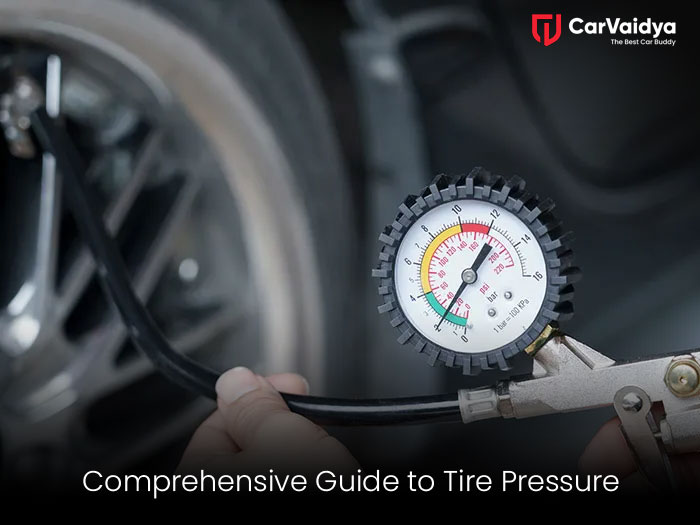Tire pressure might seem like a mundane aspect of vehicle maintenance, but it plays a crucial role in ensuring safety, fuel efficiency, and the overall performance of your vehicle. Understanding the right tire pressure for your vehicle is essential, yet it can be confusing due to various factors such as vehicle type, load, and driving conditions. In this comprehensive guide, we'll delve into everything you need to know about tire pressure, including why it matters, how to check it, and guidelines for maintaining optimal pressure levels.
Importance of Tire Pressure
Safety: Proper tire pressure ensures optimal traction, handling, and braking performance, reducing the risk of accidents.
Fuel Efficiency: Underinflated tires increase rolling resistance, leading to decreased fuel efficiency and higher fuel consumption.
Tire Wear: Incorrect tire pressure can cause uneven wear patterns, reducing tire lifespan and necessitating premature replacement.
Handling and Performance: Maintaining the recommended tire pressure enhances vehicle stability, cornering, and overall driving experience.
Understanding Tire Pressure
PSI (Pounds per Square Inch): The unit of measurement for tire pressure, indicating the amount of air pressure within the tire.
Recommended Pressure: Every vehicle comes with a manufacturer-recommended tire pressure, typically found in the owner's manual or on a placard located on the driver's side door jamb.
Overinflation vs. Underinflation: Both scenarios have adverse effects on tire performance and vehicle safety. Overinflated tires are prone to decreased traction and a harsher ride, while underinflated tires result in poor handling, increased rolling resistance, and potential tire damage.
Checking Tire Pressure
Tire Pressure Gauge: A simple tool used to measure tire pressure accurately. Analog and digital gauges are available, with digital gauges offering more precision.
How to Use a Tire Pressure Gauge: Step-by-step instructions for checking tire pressure, including removing the valve cap, pressing the gauge firmly onto the valve stem, and reading the pressure displayed on the gauge.
Frequency of Checks: It's recommended to check tire pressure at least once a month and before long trips or significant changes in temperature.
Factors Affecting Tire Pressure
Temperature: Tire pressure fluctuates with temperature changes, with colder temperatures leading to decreased pressure and warmer temperatures causing an increase in pressure.
Load: Heavier loads require higher tire pressure to support the additional weight effectively. Consult your vehicle's manual or load capacity specifications for guidance.
Driving Conditions: Aggressive driving, rough terrain, and prolonged highway speeds can increase tire temperature and pressure, necessitating periodic checks and adjustments.
Adjusting Tire Pressure
Adding Air: If tire pressure is below the recommended level, use an air compressor to inflate the tires to the specified PSI. Be sure not to overinflate, as this can lead to tire damage and reduced performance.
Releasing Air: If tires are overinflated, use a tire pressure gauge or the pressure relief valve on the air compressor to release excess air until the correct pressure is reached.
Importance of Even Pressure: Ensure that all tires have consistent pressure levels to maintain balanced handling and performance.
Tire Pressure Maintenance Tips
Regular Inspections: In addition to monthly checks, visually inspect tires for signs of damage, uneven wear, or embedded objects that could cause punctures.
Proper Inflation: Avoid relying solely on visual inspection; use a tire pressure gauge for accurate measurement and adjustment.
Spare Tire: Don't forget to check the pressure of the spare tire regularly, as it's often overlooked until needed in an emergency.
Tire Pressure and Tire Care Myths Debunked
Myth: Maximize Tire Life by Overinflating: Overinflating tires does not prolong their lifespan; it leads to uneven wear and reduced traction.
Myth: Nitrogen-Filled Tires Never Lose Pressure: While nitrogen-filled tires may experience slower pressure loss compared to air-filled tires, they still require regular checks and adjustments.
Myth: Tire Pressure Monitors Are Infallible: Tire pressure monitoring systems (TPMS) are valuable tools but can sometimes provide inaccurate readings. Manual checks with a tire pressure gauge are still necessary for verification.
Conclusion
Tire pressure is a critical aspect of vehicle maintenance that directly impacts safety, fuel efficiency, and performance.
Regular checks and adjustments are essential for maintaining optimal tire pressure levels.
By understanding the importance of tire pressure and following the guidelines outlined in this guide, you can ensure a safer, smoother, and more efficient driving experience.
You can read some other articles
Installing airbags in older car’s safety consideration and effectiveness
The benefits of timely oil changes for your car in Delhi NCR
Know everything about car service history report


0 Comments